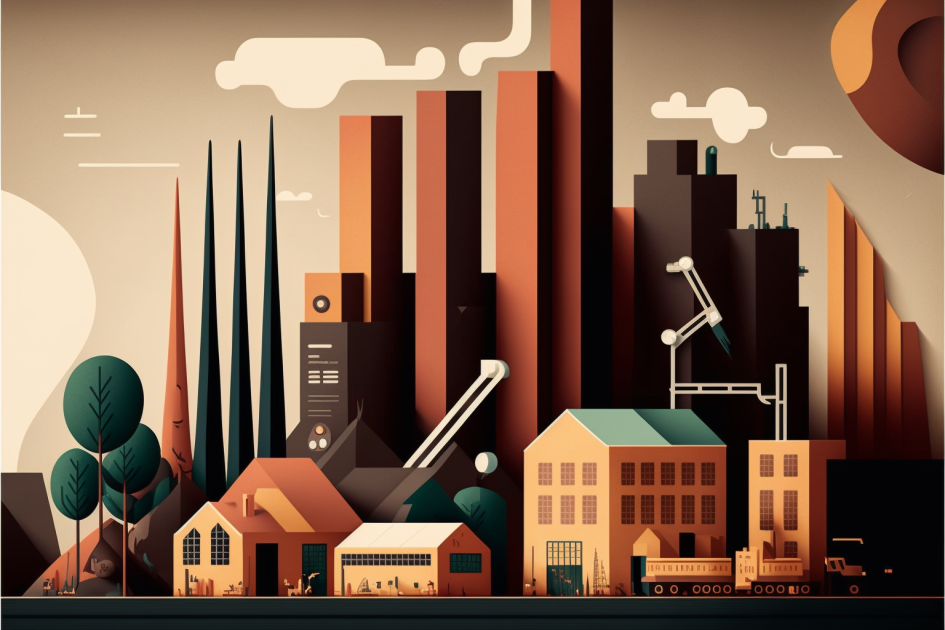I. Introduction
When it comes to understanding the economic health of a country, Gross Domestic Product (GDP) is often considered the most important metric. GDP is a measure of the total value of all goods and services produced within a country in a given time period. It is used to determine the overall size and growth of an economy, as well as its level of development. One of the key indicators of a country’s economic health is its GDP growth rate. This is the rate at which a country’s GDP is increasing or decreasing over time. A positive growth rate indicates that the economy is expanding, while a negative growth rate indicates that the economy is contracting. In this article, we will explore the impact of GDP growth rate on industry growth trends.
II. The Relationship Between GDP Growth Rate and Industry Growth
The GDP growth rate is closely tied to the growth of various industries within a country. A high GDP growth rate generally indicates that industries within the country are expanding and contributing to economic growth. Conversely, a low GDP growth rate can signal that industries are struggling and may be hindering economic growth.
- One example of the relationship between GDP growth and industry growth can be seen in China. In recent years, China’s GDP growth rate has been among the highest in the world, and this has been driven in large part by the expansion of its manufacturing and construction industries. As these industries have grown, they have created jobs and stimulated economic activity, which has in turn fueled GDP growth.
- Another example is the relationship between GDP growth and the oil industry. When oil prices are high, countries that are major oil producers, such as Saudi Arabia, tend to see a boost in their GDP growth rates. This is because the oil industry is a major contributor to their economy. Conversely, when oil prices are low, these countries may see a decline in GDP growth due to the struggles of the oil industry.
- The relationship between GDP growth and the service industry can also be seen in developed countries like United States. The service industry such as finance, healthcare, and education accounts for a large portion of the economy, and provides a stable source of economic growth. As GDP growth rate increases, the service industry also experiences growth which results in job creation and increased economic activity.
- In India, the relationship between GDP growth and the agricultural industry is an interesting one. The agricultural industry has been a significant contributor to India’s GDP growth in the past, but in recent years it has struggled to keep pace with the growth of other industries like manufacturing and services. As a result, the agricultural industry’s share of GDP has decreased, and this has had a negative impact on GDP growth.
- In Africa, the relationship between GDP growth and the mining industry is also notable. In countries like South Africa, the mining industry has been a major contributor to GDP growth in the past, but in recent years it has struggled due to declining commodity prices and other factors. As a result, the mining industry’s share of GDP has decreased, and this has had a negative impact on GDP growth.
Overall, the relationship between GDP growth and industry growth is complex and multifaceted. Different industries can have different levels of impact on GDP growth, and the relationship can change over time depending on various factors such as commodity prices, government policies, and global economic conditions.
III. Industries That Drive GDP Growth
There are certain industries that are known to have a strong impact on a country’s GDP growth rate. These include the manufacturing, construction, and services sectors. The manufacturing sector is a major contributor to GDP growth because it produces a wide range of goods that are in high demand. This includes everything from consumer goods to capital goods, such as machinery and equipment. The construction sector is also a significant contributor to GDP growth. This is because construction activity, such as building new homes and commercial properties, can create jobs and stimulate economic activity. The services sector, which includes industries such as finance, healthcare, and education, is also a key driver of GDP growth. This is because the services sector often accounts for a large portion of a country’s economy and can provide a stable source of economic growth.

IV. Industries That Can Be Affected by GDP Growth
Not all industries are equally affected by GDP growth. Some industries may be more susceptible to changes in GDP growth rate than others. For example, industries that rely heavily on consumer spending, such as retail and hospitality, may be more affected by changes in GDP growth than industries that are less consumer-dependent, such as manufacturing.
- The retail industry is heavily dependent on consumer spending and is therefore more susceptible to changes in GDP growth rate. A decrease in GDP growth can lead to a decline in consumer spending and negatively impact the retail industry. For example, during the 2008 financial crisis, there was a sharp decline in GDP growth and consumer spending, resulting in many retail stores closing and an increase in unemployment in the retail industry.
- The hospitality industry, including hotels and restaurants, is also heavily dependent on consumer spending and is therefore affected by changes in GDP growth rate. A decrease in GDP growth can lead to a decline in tourism and negatively impact the hospitality industry. For example, during the COVID-19 pandemic, there was a sharp decline in GDP growth and a decrease in travel and tourism, resulting in many hotels and restaurants closing and an increase in unemployment in the hospitality industry.
- The manufacturing industry, on the other hand, is less dependent on consumer spending and is therefore less affected by changes in GDP growth rate. A decrease in GDP growth may lead to a decline in demand for manufactured goods, but the industry may still be able to maintain stable growth through exports. For example, during the 2008 financial crisis, the manufacturing industry in China was able to maintain stable growth through exports to other countries.
- The construction industry is also less dependent on consumer spending, although changes in GDP growth rate can still impact it. A decrease in GDP growth can lead to a decline in construction activity and negatively impact the construction industry. For example, during the 2008 financial crisis, there was a sharp decline in GDP growth and a decrease in construction activity, resulting in many construction companies going bankrupt and an increase in unemployment in the construction industry.
- Similarly, the services sector, which includes industries such as finance, healthcare, and education, is also less dependent on consumer spending and is therefore less affected by changes in GDP growth rate. A decrease in GDP growth may lead to a decline in demand for services, but the industry may still be able to maintain stable growth through exports or other means. For example, during the 2008 financial crisis, the services sector in India was able to maintain stable growth through exports of IT services to other countries.

V. How Industry Growth Can Impact GDP Growth
It’s not just GDP growth that can impact industry growth trends; industry growth can also have an impact on GDP growth. For example, when industries within a country are expanding, they can create jobs and stimulate economic activity, which can in turn drive GDP growth. However, when industries are struggling, they can lead to job losses and a decline in economic activity, which can negatively impact GDP growth.
VI. Conclusion
In conclusion, the relationship between GDP growth rate and industry growth trends is complex and multifaceted. A country’s GDP growth rate can have a significant impact on the growth of various industries within the country, and vice versa. Understanding this relationship can help policymakers and business leaders make informed decisions that can promote economic growth and development.











